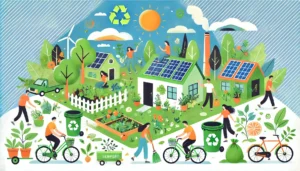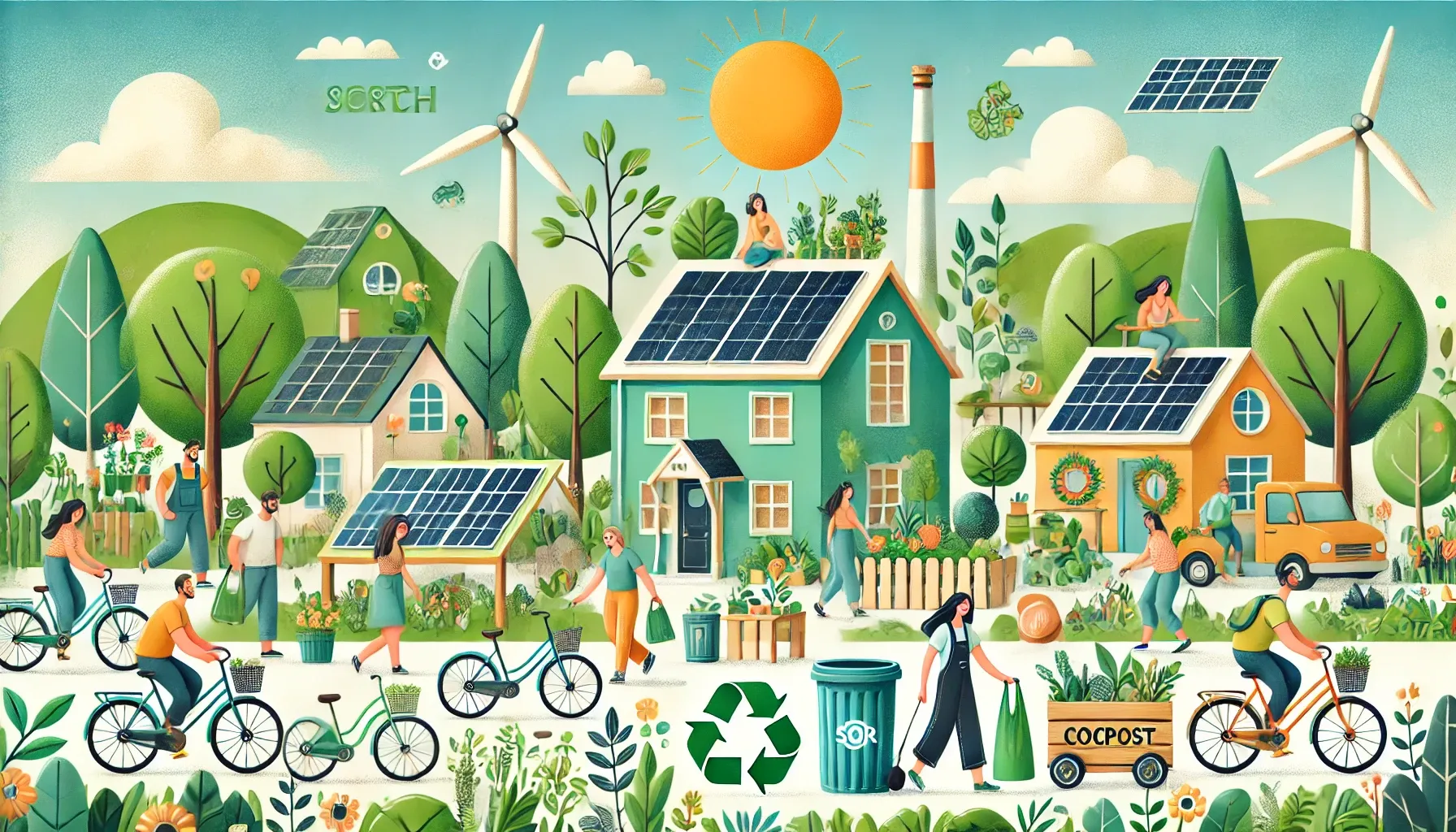Introduction
Given the current urgently needed changes in our systems (where Sustainability has grown from a choice to an imperative), it is now that adopting lifestyles designed with sustainability at their core are necessary. It offers a ray of hope for individuals who want to adopt passive mode of living, Search Here For More Blogs About Fair Market Discovery. NewIntro: This complete manual will explore the details of table circulation, offering you useful guidance and insights to assist you with making meaningful variations for your everyday lifestyle. This article will leave you with the information and motivation to live in a way that supports life, from conserving energy through wise ecological consumerism.

What is Sustainable Living?
Living sustainably means that you live in such a way where rather than being wasteful, it reduces an individual’s or society’s use of Earths natural resources and personal resources. People who practice sustainable living often attempt to reduce their carbon footprint by changing methods of transportation, energy consumption and diet. Ultimately, we aim to design and develop a lifestyle in line with the natural environment and implemented fairly for everyone.
Principles of a Sustainable Lifestyle
This foundational principle Reduce, Reuse, Recycle promotes the measures to save waste ie to reduce consumption so that less refuse is produced and also reuse/re-cycle materials.
You can help contribute individually in a large way by using energy efficient fixtures and fittings, as well as renewable sources of energy so that fossil fuels are not used.
Water Conservation – Living more sustainably means making intelligent use of water resources and protecting the natural systems that clean and distribute it.
Sustainable Transportation: This will be in the form of public transit such as Bus, Tram or Taxi biking, walking and using Fuel Efficient/ Electric vehicles.
Green Consumerism: Selecting environmentally responsible, limited packaging,and fair trade products.
Sustainable Living Hacks
Energy Efficiency at Home
Replace With Green Alternatives: ENERGY STAR appliances save water and energy upon use.
Insulate Your Home: Increase insulation to avoid heating and cooling, saves energy consumption as well the cost.
LED Lighting: LED bulbs consume up to 85% less energy than conventional incandescent lamps and have a longer lifetime.
Smart Thermostats: Change your thermostat to cycle heating and cooling systems according to the time you spend at home.
Reducing Water Usage
Repair Leaky Faucets: A single drip from an attempt of leaky faucet can squander varies in water. Repair the leakage as soon a s possible to Save Water
Low-flow Fixtures – Install low-pressure utilization devices on shower heads and tap to improve efficiency without compromising functionality.
So, this is it: Rainwater Harvesting – To be used for gardening or similar non-potable uses.
Water-Efficient Landscaping – Install drought-tolerant native plants and consider creating rain gardens to capture water runoff.
Sustainable Transportation
Take public transit: Buses, trains (preferably electric ones) and other forms of mass transportation are much more carbon-efficient ways to get around.
Carpool (share rides with friends or co-workers to get fewer vehicles on the road)
Biking and Walking: Choose Bicycling or walking for shorter trips to promote health while reducing emissions.
Electric Vehicles: Think about using an all-electric or hybrid mode of transportation for extended trips.
Eco-Friendly Consumer Choices
Philippe By Buy Local we mean buy local to reduce fuel consumption associated with transportation of products, this helps support the farmers and artisans in your community.
Stick with Organic: By modernizing our practices of organic farming, it can be a much better deal for nature and reduce the exposure to pesticides.
Quality clothing that lasts longer and can be mixed and matched the way you want.
It can be the single best method to combating plastic waste: create items with long lifetimes by avoiding Use of Single-Use Plastics: Ditch disposable bottles, bags and containers in favor of more durable goods.
Waste Reduction
Composting: It is the process of breaking down organic waste material to other objects rich, decaying matter commonly termed as compost; essentially soil(kind of).
Recycling: Adhere to your specific regional recycling standards in order for materials are properly recycled.
Adhere to digital options: switch to digital receipts, documents and communications instead of letting paper accumulate.
Donate and Recycle: Either donate the stuff you don’t want or get crafty with those things.
Sustainable Living In Different Facets of our Lives
Sustainable Food Practices
Switching to a Vegetarian or a reduction in meat and dairy consumption: Plant-Based Diet – If you are eating beef, then by comparison your carbon footprint far higher than some one who does not eat it.
Start a backyard garden: This is the simplest and most successful way of growing your own food.
Eat Seasonally: Pick produce that is in season to cut down on the energy used for transportation and storage.
Avoid Food Waste Management: Meal planning, smart food storage & leftovers utilization to reduce wastage
Sustainable Fashion
We Support Slow Fashion: Shop brands that have invested in supply chain transparency as well fair wages and sustainable practices.
Buy – Secondhand Shopping: Take advantage of clothes that someone has already used, reducing the demand from new items and making it possible to wear a garment for longer.
Care for clothing: cold water wash, hang to dry and repair clothes (The weather Viking)
Remove: Release the pieces you no longer wear or care about; After a few weeks, items that have not been worn may be placed back into your wardrobe. Capsule Wardrobe: Develop an adaptable collection containing only several high-quality items
Green Home Design
Sustainable materials: Reclaimed wood, Bamboo and sustainable home construction or refurbishments.
Windows: Replace single-glazed windows with double glazing to increase insulation for minuscule changes in home electricity usage.
Green Roofs: These provide insulation, add habitat and reduce stormwater runoff.
Reduce electricity bills and generate renewable energy: Install solar panels
Community Sustainability Feature Image
Community Gardens
Community gardens let people cultivate their own produce, pick up some tips about sustainable agriculture and meet a neighbour. They help with biodiversity, reduce food deserts and build community resilience.
Sustainable Local Action
Some communities have groups where residents can connect and find resources to support their efforts towards sustainability. Such strategies might encompass programs to recycle, incentives for energy efficiency and workshops teaching us how we can help.
Collaborative Consumption
Resources – be it tools, cars or even living spaces can be shared, reducing waste and uniting the community. Sharing and renting platforms are now more popular than ever.
Advocacy and Education
Advocate for Sustainability Practices on a Local Level – You have the power to inspire change in your community. Teach others about the importance of sustainability, and advocate for policies that increase environmental accountability.
Challenges to Encouraging Sustainability
Cost Barriers
Although you save money in the long term, there is also an intrinsic barrier to entry due to investment. Find incentives, grants and programs offered by the government that may aid in cost offset.
Access to Resources
There is also not the same level of access to sustainable products and resources. Support efforts towards community gardens and co-ops that increase entry into sustainability.
Habit Changes
Old habits die hard, and with some times modernizing long-standing practices can be tough. Think small, set achievable goals and add more sustainable habits into your daily routine over time.
Staying Informed
The field of sustainability is ever-changing. Keep updated on rising technologies, practices and policies via credible sources and be ready to shift your way of life once new information is given.
Trends in Sustainable Living Predicted for the Future
Smart Homes
Smart home technologies help control energy needs, water consumption and overall efficacy. It may include control over proximity sensors such as remote access to smart thermostats, lighting systems and appliance-specific controls which allow for improved resource management.
Renewable Energy
There is a move towards green energy (solar, wind and hydropower). These sources are becoming more economically feasible and accessible for a variety of reasons, including major advancements in the energy storage space, as well grid management.
Circular Economy
The circular economy model aims to eradicate waste in omnipal process, manufacture and discard lines. This leads to recycling, upcycling, and sustainable product development.
Sustainable Travel
Methods for eco-friendly travel, like carbon offset programs and sustainable accommodations to responsible tourism practices, are becoming increasingly popular. Travelers are looking for experiences that do minimal environmental damage and provide support to locals.
Regenerative Agriculture
The goal with regenerative agriculture is to transform farming practices so soil can regenerate and sequester more carbon back from the atmosphere. Powered This is more than sustainable – it regenerates the environment.
Conclusion
Sustainable living pertains to a general attitude that impacts every aspect of our daily routine. We can lessen our ecological footprint by becoming more aware of how we use energy, how much and what type of transportation we choose, the rate at which such goods as clothing are produced and used up (consider fast fashion), to say nothing about choices in community engagement. Discover Fair Blogs provides the information and inspiration needed to promote a green lifestyle. Together, we can all pursue sustainable methods and in the process improve our planet for both ourselves, as well as future generations. Principles of Sustainable Living & How To Apply (Infographic) There is a long way for the world to achieve sustainable living, but by learning some useful understanding and tips about this kind… energicoin.medium.com It is a learning and an infinite matter to continue this journey towards sustainability. But the rewards are very much useful (and not just for preserve) which makes up our own well-being. Sustainable living is a journey, not an end point. All baby steps count and together – we make a huge difference. Now but do your part for sustainable living and contribute to a future where we not only environmentally equal, also immigrating non-exist anymore.
